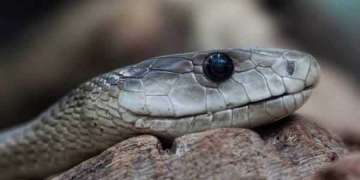Snake ancestors that lived nearly 100 million years ago, had legs and a cheekbone which have disappeared entirely in their modern day descendants, according to a study which examined fossils of an ancient rear-limbed reptile called Najash rionegrina. The study, published in the journal Science Advances, showed that snakes possessed hind legs during the first 70 million years of their evolution, and had cheekbones -- also known as a jugal bone.
The researchers, including those from the University of Alberta in Canada, also revealed how the flexible skull of the ancient snake evolved from their lizard ancestors.
Until now, understanding of the evolutionary history of early snakes was limited by the unavailability of fossil records, they said.
The nearly 100 million-year-old fossil snakes were found in Northern Patagonia -- a region at the base of South America spanning the lower sections of Argentina and Chile, they added.
"Najash has the most complete, three-dimensionally preserved skull of an ancient snake, and this is providing an amazing amount of new information on how the head of snakes evolved. It has some, but not all of the flexible joints found in the skull of modern snakes," said study co-author Alessandro Palci from Flinders University in Australia.
In the current study, they performed high-resolution scanning and light microscopy of the preserved skulls of Najash, revealing new anatomical data on the early evolution of snakes.
According to the study, Najash are closely related to an ancient lineage of snakes that populated the southern hemisphere of one of the Earth's earliest continents Gondwana, and may be related to only a small number of obscure modern snakes.
"Our findings support the idea that the ancestors of modern snakes were big-bodied and big-mouthed--instead of small burrowing forms as previously thought," said study lead author Fernando Garberoglio from Universidad Maimonides in Argentina.
According to the researchers, one of the features that set snakes apart from lizard type reptiles is their highly mobile skull, which allows them to swallow large prey items.
Palci said until now there was a lack of detailed information about the transition from the relatively rigid skull of a lizard to the super flexible skull of snakes. The study noted that the structure of the Najash's middle ear was intermediate between that of lizards and living snakes.
Unlike all living snakes, the researchers said, the ancestral reptile retained a well-developed cheekbone, reminiscent of those in lizards.
"The study also reveals that early snakes retained their hindlimbs for an extended period of time before the origin of modern snakes which are for the most part, completely limbless," Garberoglio said.
"These primitive snakes with little legs weren't just a transient evolutionary stage on the way to something better. Rather, they had a highly successful body plan that persisted across many millions of years, and diversified into a range of terrestrial, burrowing and aquatic niches," said study co-author Mike Lee from Flinders University.
ALSO READ: Scientists discover rare 'sex-specific' cells in mice brain
Latest World News
